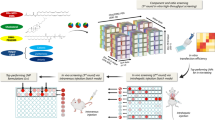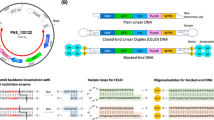Abstract
An objective of designing molecular vehicles exhibiting virus-like transgene delivery capabilities but with low toxicity and immunogenicity continues to drive synthetic vector development. As no single step within the gene delivery pathway represents the critical limiting barrier for all vector types under all circumstances, improvements in synthetic vehicle design may be aided by quantitative analysis of the contributions of each step to the overall delivery process. To our knowledge, however, synthetic and viral gene delivery methods have not yet been explicitly compared in terms of these delivery pathway steps in a quantitative manner. As a first address of this challenge, we compare here quantitative parameters characterizing intracellular gene delivery steps for an E1/E3-deleted adenoviral vector and three polyethylenimine (PEI)-based vector formulations, as well as the liposomal transfection reagent Lipofectamine and naked DNA; the cargo is a plasmid encoding the β-galactosidase gene under a CMV promoter, and the cell host is the C3A human hepatocellular carcinoma line. The parameters were determined by applying a previously validated mathematical model to transient time-course measurements of plasmid uptake and trafficking (from whole-cell and isolated nuclei lysates, by real-time quantitative PCR), and gene expression levels, enabling discovery of those for which the adenoviral vector manifested superiority. Parameter-sensitivity analysis permitted identification of processes most critically rate-limiting for each vector. We find that the adenoviral vector advantage in delivery appears to reside partially in its import to the nuclear compartment, but that its vast superiority in transgene expression arises predominantly in our situation from postdelivery events: on the basis of per-nuclear plasmid, expression efficiency from adenovirus is superior by orders of magnitude over the PEI vectors. We find that a chemical modification of a PEI-based vector, which substantially improves its performance, appears to do so by enhancing certain trafficking rate parameters, such as binding and uptake, endosomal escape, and binding to nuclear import machinery, but leaves endosomal escape as a barrier over which transgene delivery could be most sensitively increased further for this polymer.
This is a preview of subscription content, access via your institution
Access options
Subscribe to this journal
Receive 12 print issues and online access
$259.00 per year
only $21.58 per issue
Buy this article
- Purchase on Springer Link
- Instant access to full article PDF
Prices may be subject to local taxes which are calculated during checkout





Similar content being viewed by others
References
Varga CM, Wickham TJ, Lauffenburger DA . Receptor-mediated targeting of gene delivery vectors: insights from molecular mechanisms for improved vehicle design. Biotechnol Bioeng 2000; 70: 593–605.
Varga CM, Hong K, Lauffenburger DA . Quantitative analysis of synthetic gene delivery vector design properties. Mol Ther 2001; 4: 438–446.
Akinc A, Langer R . Measuring the pH environment of DNA delivered using nonviral vectors: implications for lysosomal trafficking. Biotechnol Bioeng 2002; 78: 503–508.
Forrest ML, Pack DW . On the kinetics of polyplex endocytic trafficking: implications for gene delivery vector design. Mol Ther 2002; 6: 57–66.
Abdallah B et al. A powerful nonviral vector for in vivo gene transfer into the adult mammalian brain: polyethylenimine. Hum Gene Ther 1996; 7: 1947–1954.
Boussif O et al. A versatile vector for gene and oligonucleotide transfer into cells in culture and in vivo: polyethylenimine. Proc Natl Acad Sci USA 1995; 92: 7297–7301.
von Harpe A, Petersen H, Li Y, Kissel T . Characterization of commercially available and synthesized polyethylenimines for gene delivery. J Control Release 2000; 69: 309–322.
Zanta M-A, Boussif O, Adib A, Behr J-P . In vitro gene delivery to hepatocytes with galactosylated polyethylenimine. Bioconj Chem 1997; 8: 839–844.
Thomas M, Klibanov AM . Enhancing polyethylenimine's delivery of plasmid DNA into mammalian cells. Proc Natl Acad Sci USA 2002; 99: 14640–14645.
Godbey WT et al. Poly(ethylenimine)-mediated transfection: a new paradigm for gene delivery. J Biomed Mater Res 2000; 51: 321–328.
Lynn DM, Anderson DG, Putnam D, Langer R . Accelerated discovery of synthetic transfection vectors: parallel synthesis and screening of a degradable polymer library. J Am Chem Soc 2001; 123: 8155–8156.
Zelphati O, Szoka F . Mechanism of oligonucleotide release from cationic liposomes. Proc Natl Acad Sci USA 1996; 93: 11493–11498.
Lappalainen K et al. Intracellular distribution of oligonucleotides delivered by cationic liposomes: light and electron microscopic study. J Histochem Cytochem 1997; 45: 265–274.
Godbey W, Wu K, Mikos A . Size matters: molecular weight affects the efficiency of polyethylenimine) as a gene delivery vehicle. J Biomed Mater Res 1999; 45: 268–275.
Kunath K et al. Low-molecular-weight polyethylenimine as a non-viral vector for DNA delivery: comparison of physicochemical properties, transfection efficiency and in vivo distribution with high-molecular-weight polyethylenimine. J Control Release 2003; 89: 113–125.
Schaffer DV, Fidelman NA, Dan N, Lauffenburger DA . Vector unpacking as a potential barrier for receptor-mediated polyplex gene delivery. Biotechnol Bioeng 2000; 67: 598–606.
Hong K, Sherley J, Lauffenburger D . Methylation of episomal plasmids as a barrier to transient gene expression via a synthetic delivery vector. Biomol Eng 2001; 18: 185–192.
Verma M . Viral genes and methylation. Ann NY Acad Sci 2003; 983: 170–180.
Fredman JN, Engler JA . Adenovirus precursor to terminal protein interacts with the nuclear matrix in vivo and in vitro. J Virol 1993; 67: 3384–3395.
Webster A et al. Role of preterminal protein processing in adenovirus replication. J Virol 1997; 71: 6381–6389.
Verma RS, Giannola D, Shlomchik W, Emerson SG . Increased efficiency of liposome-mediated transfection by volume reduction and centrifugation. Biotechniques 1998; 25: 46–49.
Godbey WT, Wu KK, Mikos AG . Tracking the intracellular path of poly(ethylenimine)/DNA complexes for gene delivery. Proc Natl Acad Sci USA 1999; 96: 5177–5181.
Nejjari M et al. Expression, regulation, and function of alphaV integrins in hepatocellular carcinoma: an in vivo and in vitro study. Hepatology 2002; 36: 418–426.
Bergelson JM . Receptors mediating adenovirus attachment and internalization. Biochem Pharmacol 1999; 57: 975–979.
Acknowledgements
This work was supported by the NSF Biotechnology Process Engineering Center at MIT. We are grateful to Dr Thomas Wickham for very helpful comments and suggestions.
Author information
Authors and Affiliations
Rights and permissions
About this article
Cite this article
Varga, C., Tedford, N., Thomas, M. et al. Quantitative comparison of polyethylenimine formulations and adenoviral vectors in terms of intracellular gene delivery processes. Gene Ther 12, 1023–1032 (2005). https://doi.org/10.1038/sj.gt.3302495
Received:
Accepted:
Published:
Issue Date:
DOI: https://doi.org/10.1038/sj.gt.3302495
Keywords
This article is cited by
-
Adenoviral vector DNA for accurate genome editing with engineered nucleases
Nature Methods (2014)
-
Non-viral vectors for gene-based therapy
Nature Reviews Genetics (2014)
-
Synthesis and characterization of biodegradable amphiphilic triblock copolymers methoxy-poly(ethylene glycol)-b-poly(L-lysine)-b-poly(L-lactic acid)
Journal of Polymer Research (2012)
-
Gene Therapy: A Pharmacokinetic/Pharmacodynamic Modelling Overview
Pharmaceutical Research (2010)



